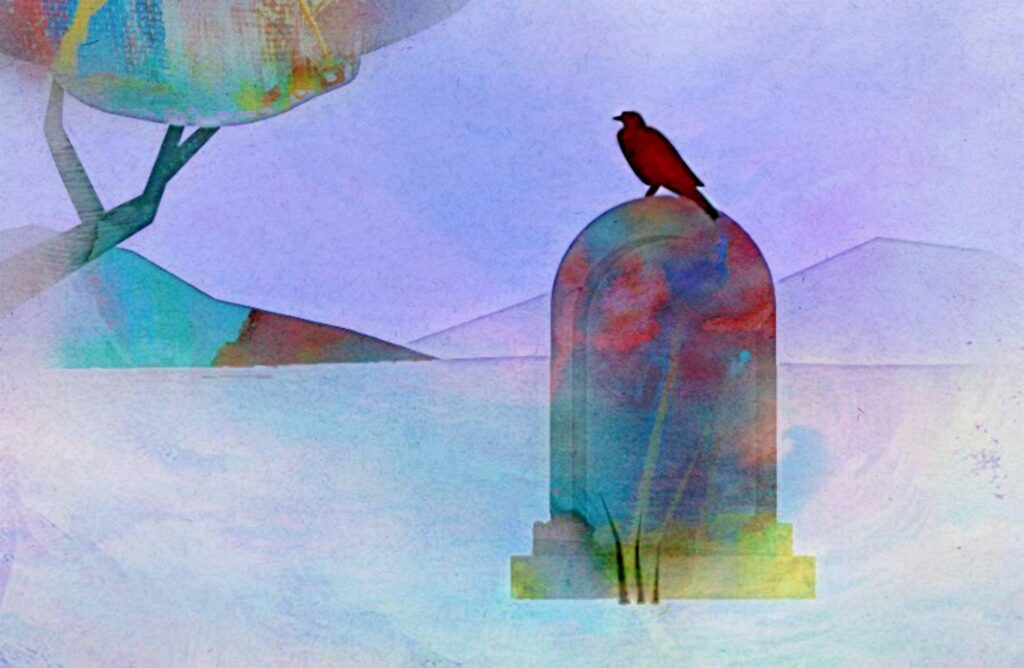I lost someone important to me in 2022.
This someone was the first love of my 30s. And someone who I can confidently say was one of the great loves of my life.
In public health, we talk about death. But we don’t talk about grief or bereavement.

We aim to protect, preserve, and promote the health of individuals and their communities. We’re terribly outcomes-driven in this respect—we want results.
But when these people die, we become fixated on the drivers of mortality. We ask: Why? How? When? Let’s understand this type of mortality and, if possible, prevent it in the future.
We focus on the drivers of mortality because the outcomes are believed to be one and the same: they’re dead. Nothing more to think about on that front.
We don’t examine the health effects of this person’s absence. We don’t study the hole left behind in the family system or social sphere. We don’t consider how this loss sends ripples across the kinship network. In any given community, the death of one person could impact the social, psychological, and material realities of many.
In this sense, it’s odd that we rarely think about death as an exposure with downstream health risks. I know firsthand that the health impact of death becomes utterly embodied during times of grief and bereavement.
cw: extensive discussion of suicide
It is puzzling that when we study mental health morbidity in LGBTQ+ populations, we only think of suicide as an outcome. An outcome with an uncomfortably high prevalence, especially for those who are multiply marginalized. But we never think of it as an exposure.
We don’t think of attempted, completed, or ideated suicides as phenomena that have a dose-response relationship with the wider community’s physical and psychological well-being. There’s some language around suicide triggering suicidality among others in the aftermath. But there remains low interest in investigating the cumulative effects of chronic exposure to suicide (attempted, completed, or ideated).
We don’t know how the intensity, frequency, or timing of it affects the health status of LGBTQ+ persons or communities. We don’t ask how this particular violence factors into future wellness and quality of life.
So again: I lost someone important to me in 2022. We met at the juncture of my turning 30 while she herself was 35.
She had a long history of self-harm and suicidal ideation. As a teen, she tried to take her own life and was nearly successful. I learned this over the course of a year-long friendship that turned into a few weeks of dating.
It is a surreal thing to meet someone who is living on stolen time. They should be dead already, after all. It is so abstract, this sense of knowing that your ever meeting them is a miracle.
A miracle that they somehow got past age 17. That they lived past running away from home, across the country. That they lived past the Christian camp and conversion therapy. That they lived past the workplace violence (verbal and physical).
A miracle that they lived past the final utterances of family rejection. That they lived past the divorce steeped in deep wounding. That they lived past the ultimate betrayal of being given up on repeatedly.
And all of this was because they’re LGBTQ+.
The chance to meet that kind of someone is a miracle. And the chance to love them feels like catching Halley’s Comet in your hands. It is a once-in-a-lifetime burning and scarring of the skin, an exquisite pain you’ll never know again.
You already know this or you come to know this.
And after this someone has passed through your life, you will want to whisper into the ear of every person mourning ‘the years of life lost’, ‘the foreclosed future’, and ‘the life cut short’, that this someone was never meant to age. That perhaps, this was the oldest that they ever could have possibly been.
Was this death actually premature considering the circumstances of this someone’s life? Considering how long they lived on stolen time? It is a sobering thing to admit. But it is the most compassionate thing I’ve come up with.
It makes my own relationship with the future more tenable. It quiets the survivor’s guilt enough to become tolerable.
Recently, Them published an article titled “Over a Third of LGBTQ+ Youth Do Not Believe They Will Live Past 35.” The article discusses the Trevor Project’s 2023 U.S. National Survey on the Mental Health of LGBTQ Young People.
An excerpt from the article: “The report found that 36% of LGBTQ+ youth from 13-24 believed they had a low chance of living to age 35. […] According to the report, young people who had reported having a suicide attempt in the last year were also more likely to report a low sense of life purpose and were less likely to believe they would live past age 35.”
My someone died right after turning 36. She had posted online that she hoped her 36th spin around the sun would be the “least eventful” of her life. In the end, I only got to celebrate that one birthday with her.
I saw the Them article and didn’t have much of a reaction. We have been living through historic times of death, dying, and loss since 2020.
By viewing death as an exposure, we can move to better understand the health consequences of grief and bereavement for all of us.
Bereaved persons have an increased risk of mortality, hospitalization, and clinical depression 0-6 months after a loss.
Bereaved persons may suffer from an array of symptoms affecting physical health (e.g. headaches, dizziness, indigestion, and chest pain), mental health (e.g. depression, anxiety, suicidal ideation, insomnia, and difficulty concentrating), and emotional health (e.g. distress, loneliness, and social withdrawal). (See “America’s Lack of Bereavement Leave Is Causing a Grief Crisis,” 2022 and “Health outcomes of bereavement,” Stroebe, 2007.)
By viewing suicide as an exposure, we can better understand grief and bereavement in the LGBTQ+ community.
In public health, Minority Stress™️ is a framework used to understand ‘unexplainable’ health phenomena that can only be chalked up to the stress burden of minority status. Minority Stress™️ seeks to understand how anticipated, perceived, and experienced victimization negatively impact the health of persons, driving health disparities and poor health outcomes.
The Minority Stress™️ model is heavily employed in the LGBTQ+ health literature and continues to be developed and iterated upon (Meyer, 2003). In simplified terms, Minority Stress™️ operates in the world through external minority stressors (stressors from outside the individual) and internal minority stressors (stressors from inside the individual). Key external minority stressors include stigma, discrimination, rejection from primary social supports, and violence. Key internal minority stressors include internalized homophobia, expectations of rejection, and identity concealment.
What’s important is that Minority Stress™️ positions the stress burden of minority status as both an exposure and a mediating variable on pathways that produce health disparities. Suicide is both an external and an internal minority stressor that operates in this unique way within the LGBTQ+ community.
The sheer scale of pandemic-related death and grief in 2020 spurred psych professionals to add Prolonged Grief Disorder (PGD) to the DSM-5. It was formally added in March 2022.
For adults, a PGD diagnosis requires that the deceased has passed at least 1 year ago and that the bereaved experiences at least 3 of the following symptoms:
- Identity disruption (such as feeling as though part of oneself has died).
- Marked sense of disbelief about the death.
- Avoidance of reminders that the person is dead.
- Intense emotional pain (such as anger, bitterness, sorrow) related to the death.
- Difficulty with reintegration (such as problems engaging with friends, pursuing interests, planning for the future).
- Emotional numbness (absence or marked reduction of emotional experience).
- Feeling that life is meaningless.
- Intense loneliness (feeling alone or detached from others).
It is important to note that: 1) “An estimated 7%-10% of bereaved adults will experience the persistent symptoms of prolonged grief disorder” and 2) “The risk for prolonged grief is also greater when the death of the loved one happens very suddenly or under traumatic circumstances.”
PGD is clinically differentiated from normal grief as a “persistent, enduring, and disabling grief.”
Society doesn’t stop for normal grief or PGD. There is no federal mandate requiring employers to provide bereavement leave, paid or unpaid; schools and universities have no obligation either. A 2016 report conducted by the Society for Human Resource Management (SHRM) found that standard bereavement leave policies offer the following amounts of time off: 4 days for the death of a spouse or child; 3 days for the death of an immediate family member; 1 day for an extended family member; and 0 days for a friend or colleague.
Zero days for my someone. Zero days for LGBTQ+ persons whose friends and partners (aka “chosen family”) are their version of losing a spouse, child, or family member.
My someone died while I was in graduate school for my Master’s in Public Health. Admin told me in no uncertain terms that I was to withdraw from my classes, take medical leave, and come back in one year. On the advice of a friend, I proposed that I would withdraw from one class and request an incomplete grade in another.
I needed to stay in school and I fought this fight alone. The School of Public Health made sure that my last 1.5 semesters would be an administrative and interpersonal nightmare. Yes, a School of Public Health.
My health deteriorated until one day I found myself standing in my living room, with my shoes on, ready to admit myself to the hospital; suicide hotlines, therapy, medications, all of it wasn’t enough to stabilize me. I can now confidently say that an Intensive Outpatient Program (IOP) for LGBTQ+ adults saved me.
During that time, I struggled to explain why I was a tinderbox for grief. When my someone died, multiple LGBTQ+ friends shared with me their losses from the last year. When my someone died, multiple LGBTQ+ friends shared with me that they’ve been inpatient and/or did an IOP. When my someone died, I was saddened to learn how many of us were grieving alone, quietly.
In public health, a new concept is emerging called “disenfranchised grief,” sometimes known as Stigmatized Grief™️ (Bristowe, 2016; Lucas, 2022). Stigmatized Grief™️ is a grief that cannot be shared openly because the person who passed was stigmatized by society, or the manner in which they passed was stigmatized.
My someone was a trans femme who committed suicide. There’s no road map for grieving this person outside of the LGBTQ+ community; it was safer to grieve alone. I withdrew into myself and kept my distance from everyone.
After my someone’s death, her biological family and ex-wife wanted to minimize LGBTQ+ attendees at her memorial. It now explains why I learned of the memorial through word of mouth. It now explains why the attendance was so small.
I didn’t know this until after; until after I had hugged her sister and gave my condolences; until after I gave her ex-wife a ride in my car. I didn’t know that her friends weren’t allowed into her apartment to claim her belongings; I didn’t know that my 36th birthday gift to her was being held hostage by the very people who had cut her out of their lives.
The bereaved parts of me are still reconnecting like severed nerve endings. After a long period of dormancy, the bereaved parts of me are coming alive again.
I can now let myself remember that final time she sat in the passenger seat of my car, my hand in her hand, then my hand on her knee. She declared that the first order of business in the fall would be to change the name on her passport. Halloween was her favorite holiday—her religious family never celebrated it growing up—and she was determined that we go to a pumpkin patch together, as she had never been to one.
She passed in October.
I remember fondly the final time I was at her apartment. We had dinner at a picnic table in the grassy yard of her building. We ordered Chinese food and lugged a cheap bottle of prosecco outside. It was summer. It was dark out. I was preoccupied with worrying about an errant raccoon coming over.
While I sat across from her, I told her this moment felt like we were college students meeting in the dining hall before summer break. It felt like we were friends newly connecting at the end of the semester, before one goes abroad. It’s a goodbye with someone you were excited to have just met. And now you have to wait for them to come back.
In my journal entry about that night, I wrote (sic):
But something I’m trying to say is one of the last things I said at that picnic table is that it felt like I was saying goodbye to a friend who’s about to leave for study abroad. It had a summer vacation feel and it was literally summer but study abroad in that she was going on an adventure and to have a meaningful experience and to find herself, but somewhere else.
A few months ago, I sat with a friend to discuss the reality of grief: how painful the process is and how, so much, you just want to be okay.
But to get to that state of being okay means that you will no longer be in the process of losing. What you love will finally be lost. The process is done. What you love is gone.
I’ve only recently allowed myself to say the words: “I miss her.”
I miss her. I miss her terribly.
I miss her and I’m trying not to grieve alone anymore.
















My wife has had a difficult time adjusting to her mom’s death a couple of years ago. I can’t say that I miss my mother who also died five years ago. She committed me twice to mental hospitals and was unrepentant about it.
Report comment
So sad. Take care. <3 All power to you.
Report comment
I cannot tell you how much this public posting of your personal story of suicide and grieving amongst the LGBTQI+ world means to me & to all humans, straight or not. Thank you! Thank you! Thank you! I really cannot emphasize this more—we are all humans, & all humans are different from each other.
Visibility will make LGBTQI+ incidental. Keep telling your story!!
Report comment